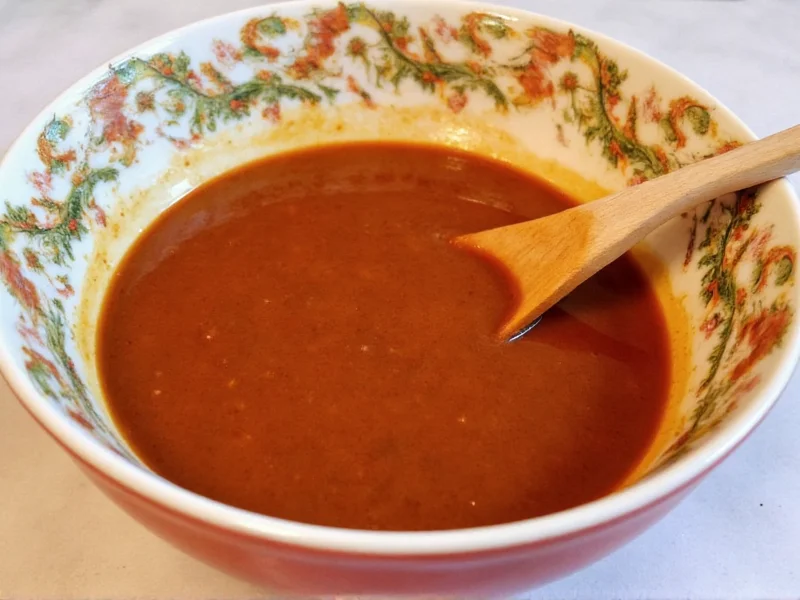Chipotle adobo sauce—a rich, smoky, and slightly sweet purée of smoked jalapeños in a tangy tomato-vinegar base—is a staple in Mexican and Southwestern cooking. When you're out of this versatile ingredient or need alternatives for dietary preferences, finding an effective replacement becomes essential. Whether you're making enchilada sauce, marinades, or roasted vegetables, these substitutes maintain the complex flavor profile while accommodating pantry limitations.
Top 5 Chipotle Adobo Sauce Substitutes
1. Smoked Paprika Blend (Closest Flavor Match)
This homemade alternative best replicates the signature smokiness without requiring specialty ingredients. Combine:
- 1 teaspoon smoked paprika (not sweet paprika)
- 1 tablespoon tomato paste
- 1 teaspoon apple cider vinegar or white vinegar
- 1/4 teaspoon garlic powder
- 1/4 teaspoon onion powder
- Pinch of sugar (optional)
- 2-3 tablespoons water to adjust consistency
Mix thoroughly until smooth. This chipotle peppers in adobo substitute without chipotle works exceptionally well in sauces and marinades where smoke flavor dominates.
2. Chipotle Powder Mixture (Most Convenient)
When you have chipotle powder but lack the canned peppers:
- 1 teaspoon chipotle powder
- 2 tablespoons tomato sauce or passata
- 1 teaspoon vinegar
- 1/4 teaspoon garlic powder
- 1/8 teaspoon cumin
This easy chipotle adobo sauce replacement delivers concentrated heat with less liquid content, making it ideal for rubs and dry marinades. Reduce liquid in your recipe by 1-2 tablespoons when using this substitute.
3. Liquid Smoke Alternative (Pantry-Friendly)
For those without smoked paprika or chipotle powder:
- 1/2 teaspoon liquid smoke (use hickory, not mesquite)
- 2 tablespoons tomato sauce
- 1 teaspoon vinegar
- 1/4 teaspoon garlic powder
- 1/4 teaspoon smoked sea salt
This mild chipotle adobo sauce substitute provides the essential smokiness but lacks natural heat. Add cayenne pepper (1/8 teaspoon) for spiciness. Best for soups and stews where subtle smoke flavor is needed.
4. Canned Chipotle Peppers in Alternative Sauce
If you have canned chipotle peppers but no adobo sauce:
- 1-2 canned chipotle peppers, finely minced
- 2 tablespoons tomato sauce
- 1 teaspoon vinegar
- 1/4 teaspoon garlic powder
- 1 teaspoon olive oil
This option preserves authentic heat while creating a chipotle adobo sauce alternative for marinades. The oil helps distribute heat evenly through your dish.
5. Ancho Chili Powder Blend (Milder Option)
For those sensitive to heat but wanting smoky depth:
- 1 teaspoon ancho chili powder
- 1/2 teaspoon smoked paprika
- 1 tablespoon tomato paste
- 1 teaspoon vinegar
- 1/4 teaspoon oregano
This homemade chipotle adobo sauce substitute offers complex flavor with about half the heat of traditional adobo sauce. Perfect for family-friendly dishes.
| Substitute | Smoke Level | Heat Level | Best For | Ratio to Replace 1 Tbsp Adobo |
|---|---|---|---|---|
| Smoked Paprika Blend | ★★★★☆ | ★★★☆☆ | Sauces, dips, dressings | 1:1 |
| Chipotle Powder Mix | ★★★☆☆ | ★★★★☆ | Rubs, dry marinades | 1:1 (reduce other liquids) |
| Liquid Smoke Alternative | ★★★☆☆ | ★☆☆☆☆ | Soups, stews, braises | 1:1 + cayenne for heat |
| Canned Chipotle Peppers | ★★★★★ | ★★★★★ | Authentic Mexican dishes | 1:1 |
| Ancho Chili Blend | ★★★☆☆ | ★★☆☆☆ | Family meals, mild recipes | 1:1 |
How to Adjust Substitutes for Different Recipes
For Sauces and Dressings
When making chipotle mayo substitute or creamy dressings, use the smoked paprika blend but reduce vinegar by half. The acidity can cause dairy to curdle. Add 1 teaspoon of the substitute per 1/4 cup of base sauce, tasting as you go.
For Marinades
For meats and vegetables, the chipotle powder mixture works best. The concentrated flavor penetrates proteins effectively. Add 1 extra teaspoon of oil to help the substitute adhere to food surfaces. Marinate for at least 2 hours to allow smoke flavors to develop.
For Soups and Stews
In liquid-based dishes, the liquid smoke alternative shines. Add it near the end of cooking to preserve volatile smoke compounds. Start with half the recommended amount, then adjust—smoke flavor intensifies as the dish sits.
Common Substitution Mistakes to Avoid
Overcompensating for smoke flavor: Liquid smoke is potent—use half the amount you think you need, then adjust. Too much creates an artificial, campfire-like taste.
Ignoring acid balance: The vinegar in adobo sauce provides crucial brightness. When substituting, maintain the 3:1 tomato-to-acid ratio to prevent flat-tasting results.
Misjudging heat levels: Canned chipotles vary in spiciness. When using the chipotle powder substitute, start with 1/2 teaspoon and work up—powder concentrates the heat without the moderating effect of the adobo sauce liquid.
Incorrect measurements: Always measure substitutes by volume, not weight. A tablespoon of tomato paste has different density than liquid adobo sauce, affecting flavor concentration.











 浙公网安备
33010002000092号
浙公网安备
33010002000092号 浙B2-20120091-4
浙B2-20120091-4